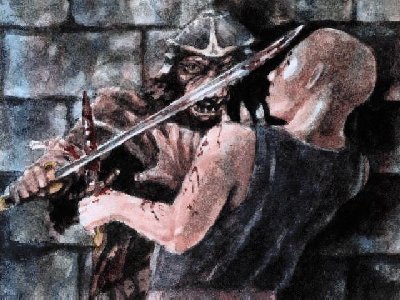 Chapter 15
Chapter 15  Chapter 15 Chapter 15 |
Combat |
Many weapons can be used in more than one way. For instance, a dagger may be thrown or held in the hand. Bastard swords may be used one-handed or two-handed. And most weapons can be used in the left hand or the right.
Each method uses a different skill. However, any two specializations of the same weapon are automatically similar skills, at a ratio of 1/2. When a weapon has more than one method of use you must choose a specialization. Since the vast majority of characters will always use a weapon in their dominant hand, we will assume that any weapon skill you develop applies to that hand unless otherwise specified. (Thus, if you switch to the other hand, use the similar skill to figure out what your effective SV is.)
 15.1.2 Similar Weapons
15.1.2 Similar WeaponsWeapon skills use the same Similar Skill rules as all other skills. However, they are even simpler. All similar weapon skills are mutually similar. That is, if weapon A can use weapon B as a donor skill, then weapon B can also use weapon A. All weapon skills are similar at a ratio of 1/4. (Of course, that doesn't include different skills for specializations of the same weapon as described above.)
For some weapons, there is more you can do with them than just attack. For example, a boomerang can come back, and the user can catch it and re-use it if it missed. An axe, a tonfa, and a polearm can be used as weapons or in their original capacity as tools. Whenever a weapon has a secondary use, this requires a second skill. Some of these skills are listed elsewhere (for instance, using a hammer to build cabinets would fall under Carpentry) but those that are combat-oriented, such as catching a returning boomerang, are not. The GM will have to make up stats for this on a case-by-case basis. No exhaustive list is printed here because players will come up with endless new uses for weapons that would not have been considered. In most cases the "alternative use" skill should be similar to the weapon skill at a rate of 1/3 or 1/4, and vice versa.
To find the stats, difficulty modifiers, and untrained values for weapon skills, consult the reference list of all skills. Each weapon is listed there in alphabetical order. (None of them are listed "last name first" (e.g., Crossbow, Light).)
Weapons have one additional piece of information listed there, their Weapon Speed, which is used in the IRIS Initiative System. Since all weapons are always COMBAT skills, the weapon speed is listed in parentheses after the CO under "Cat."
 15.2 Weapons Without Charts
15.2 Weapons Without ChartsA number of medieval weapons do not have their own charts in Arms Law & Claw Law™. For these weapons, you will use the chart of a similar weapon with modifiers. Listed below is a selection of popular weapons without charts, along with the statistics you need to use them. These statistics are:
| Weapon | Table Used | F | Mods for ATs up to | Mods for Ranges up to | Notes | ||||||||
| 4 | 8 | 12 | 16 | 20 | 10' | 25' | 50' | 100' | 150' | ||||
| Armored Fist | Bare First | 1 | 0 | 0 | 0 | 0 | 0 | No skill applies. | |||||
| Bastard Sword (1-H) | Broadsword | 4 | -10 | -10 | -5 | 0 | +5 | ||||||
| Bastard Sword (2-H) | Two-Hand Sword | 5 | -10 | -10 | -5 | -5 | -5 | ||||||
| Black Powder Guns | Small Proj MkI | 7 | -20 | -20 | -20 | -20 | -20 | as 5mm light rifle | Takes a minute to load | ||||
| Blackjack | Bare Fist | 1 | 0 | 0 | 0 | 0 | 0 | E crits become D crits | |||||
| Blow Gun | Sling | 5 | +10 | +5 | 0 | +10 | -5 | 0 | 0 | -20 | -40 | All crits are Punctures | |
| Boar Spear | Spear | 5 | -5 | 0 | 0 | +5 | +5 | -15 | -30 | Hard to remove | |||
| Boomerang | Club | 4 | -5 | -5 | -5 | -5 | -5 | 0 | 0 | 0 | -20 | -30 | Separate skill to make it return |
| Cat of Nine Tails | Whip | 7 | +10 | 0 | -5 | -10 | -15 | ||||||
| Claymore | Two-Hand Sword | 4 | +5 | +5 | -5 | -5 | -5 | ||||||
| Cudgel | Club | 3 | +10 | +10 | +5 | +5 | +5 | -35 | |||||
| Cutlass | Broadsword | 3 | -5 | -5 | -5 | 0 | +5 | -20 | |||||
| Dart | Dagger | 5 | 0 | 0 | 0 | +5 | -10 | 0 | -10 | -20 | All crits are Punctures | ||
| Dirk | Dagger | 1 | -5 | -5 | 0 | +5 | +5 | -15 | -30 | -40 | |||
| Foil | Dagger | 3 | +10 | +10 | +10 | +10 | +10 | All crits are Punctures | |||||
| Harpoon | Javelin | 4 | -5 | -5 | -5 | -5 | -5 | -5 | -20 | Hard to remove | |||
| Jo (one-handed) | Quarterstaff | 5 | 0 | 0 | 0 | 0 | 0 | ||||||
| Jo (two-handed) | Club | 3 | +5 | +5 | +5 | +5 | +5 | ||||||
| Katana | Broadsword | 3 | +5 | +5 | +5 | 0 | 0 | ||||||
| Lance (jousting) | Lance | 7 | 0 | 0 | +5 | +10 | +10 | All crits are As; uses Lances skill | |||||
| Lance (unmounted) | Javelin | 7 | 0 | 0 | 0 | 0 | 0 | Uses Lances skill | |||||
| Lasso | Grapple | 6 | 0 | 0 | 0 | 0 | 0 | 0 | Max. result is Medium | ||||
| Longsword | Broadsword | 4 | -5 | -5 | 0 | +5 | +5 | ||||||
| Pick | War Mattock | 6 | -10 | -10 | -10 | -10 | -10 | ||||||
| Pilum | Javelin | 5 | +5 | +5 | +5 | +5 | +5 | 0 | -20 | -30 | |||
| Sabre | Broadsword | 3 | -5 | -5 | -5 | -5 | 0 | ||||||
| Sai | Maine Gauche | 2 | -5 | -5 | -5 | -5 | -5 | -20 | -20 | ||||
| Shuriken | Dagger | 5 | +10 | +10 | +10 | +5 | +5 | 0 | 0 | -20 | -30 | ||
| Tomahawk | Handaxe | 2 | -10 | -10 | -10 | -10 | -10 | -5 | -15 | -30 | |||
| Tonfa | Club | 4 | +10 | +10 | +10 | +10 | +10 | ||||||
| Trident | Spear | 5 | +10 | +10 | +5 | +5 | 0 | -15 | -30 | -40 | |||
| Woodsman's Axe | Handaxe | 4 | -5 | -5 | -5 | -5 | -5 | -30 | |||||
 15.3 Critical Control
15.3 Critical ControlIt often occurs in play that a character desires to control some aspect of a critical strike, rather than allowing the dice to rule. There are two cases in which this usually occurs. Sometimes a character will aim for some part of the body, perhaps because a particular creature is vulnerable there, or for any of many other reasons. On other occasions, a character wants to hit someone but do little or no permanent damage, in hopes of knocking the foe out without hurting them, or just to show the foe what they're capable of. The rules as presented in Arms Law & Claw Law™ make no provision for this.
To control a critical in this way, the player must announce his precise intentions before beginning the attack. Normally, on an attack, the player announces how much of his OB to allot to the attack and how much to parrying. When controlling the critical, the player must also decide how much of his/her OB to spend on controlling the critical. For example, Tomalfson, with an OB of 24 in Broadsword, decides to try to attack a foe without doing any permanent damage (i.e., "use the flat of the blade"). He decides to allot 10 points to the attack, 5 to parrying, and 9 to controlling the critical.
The attack is then rolled and any hits damage are done. If the attack roll produces a critical, the player must make a maneuver roll using that part of the OB that was allocated for controlling the critical. The GM will apply modifiers for general difficulty and other circumstances as usual. The interpretation of the result on the SM chart may depend on what the character is trying to accomplish. Listed here are some results for the two aforementioned goals (striking a certain part of the body, and reducing permanent damage).
When the character is trying to place an attack at a precise place, consider the critical that was rolled. If no strike location is given, apply it as is. If the location given is similar to the intended location (e.g., ankle for wrist, chest for back, etc.) apply it, using the new location in place of the old one. A few such criticals will require some slight modification (e.g., an ankle strike that gives a minus to movement might be converted to a wrist strike that gives a minus to maneuvers with that hand). If the indicated critical's strike location is very different from the desired one, reroll and try again.
Deciding how close the strike location must be to the desired location before you reroll is an important part of this process. After all, if the player successfully deals a blow to the head using this rule and you apply a critical intended for a wrist, the player will be justifiably miffed. And worse, if you adapt a head strike to an attack to the leg, things will begin to seem absurd. Many target locations will force you to reroll several times until you get an appropriate critical, and in some cases, the only criticals that can apply are the lowest or highest criticals in that column. You may want to skim that column and choose the most appropriate one instead of rerolling, if there are only one or two that are appropriate at all.
 When trying to reduce permanent damage, you'll be using the Stun critical chart, which was presented in the Rolemaster Companion™ series. If you don't have access to this chart, you can "fake it" (though the results are a little less satisfactory and take longer to generate). Multiply the critical roll by 0.3 for an A crit, 0.4 for a B crit, 0.5 for a C crit, 0.6 for a D crit, or 0.7 for an E crit. The result is the number of hits damage the blow can do. The attacker may exchange damage for other effects as follows:
When trying to reduce permanent damage, you'll be using the Stun critical chart, which was presented in the Rolemaster Companion™ series. If you don't have access to this chart, you can "fake it" (though the results are a little less satisfactory and take longer to generate). Multiply the critical roll by 0.3 for an A crit, 0.4 for a B crit, 0.5 for a C crit, 0.6 for a D crit, or 0.7 for an E crit. The result is the number of hits damage the blow can do. The attacker may exchange damage for other effects as follows:
For instance, Tomalfson scores a C critical which he does with the flat of his blade. He rolls 93 for his critical roll. 93 x 0.5 is 46.5 which rounds to 47. Tomalfson could choose to do 47 hits of damage, but decides instead to spend 12 of those points on two rounds of stun/no parry. He does 35 points of damage and two rounds of stun/no parry. Compared to most C criticals with a 93 roll, this is a much milder blow, though just as effective for the purposes of knocking someone out, which is just what Tomalfson intended.